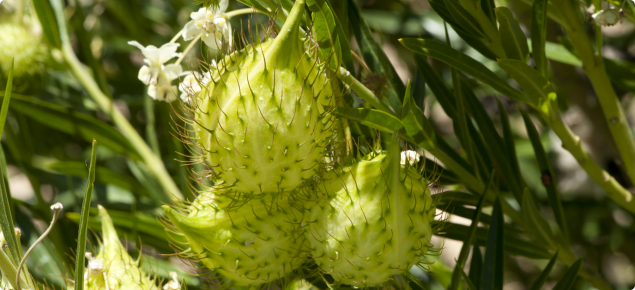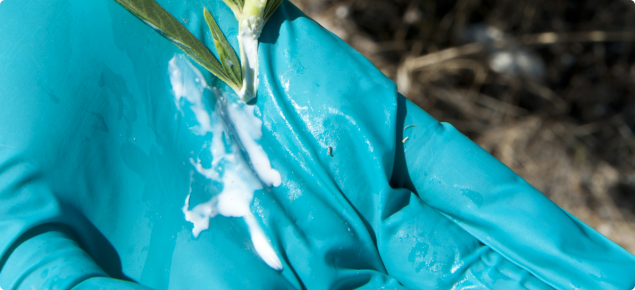Form: shrub — perennial
Status: present in WA
Appearance
An erect slender short-lived shrub one to two metres high, with narrow opposite leaves, and bladder-like fruit. All parts of the plant exude a milky white sap when damaged. It reproduces by seed and suckers.
Stems: pale green, 60-180 centimetres high, covered with short whitish downy hairs when young.
Leaves: dull green, occasionally with shiny upper surface. They are 5-12 centimetres long, 6-18 millimetres wide tapering to a point and are opposite each other in pairs.
Flowers: white or creamy with five fringed waxy lobes turned sharply outwards. They are formed in a loose drooping cluster of three to ten flowers in the leaf axils.
Fruit: distinctive seed pods that are puffy, swan-shaped structures up to six centimetres long and 2.5 centimetres wide and covered in soft spines up to one centimetres long.
Seeds: contained within a thin walled sack that is separated from the outer wall by an air space. Brown coloured, flattened and egg shaped about six millimetres long and three millimetres wide with a tuft of silky hairs about three centimetres long at one end.
Online weed identification training
Login or set up a new account on DPIRDs online training site to access:
- a training course on how to identify cotton bush and report it.
- training material that you can use to teach community groups how to identify cotton bush.
Agricultural and economic impact
Cotton bush invades pastures and can form dense thickets many hectares in size. It is toxic to livestock but is rarely eaten.
Declared pest category
The Western Australian Organism List (WAOL) contains information on the area(s) in which this pest is declared and the control and keeping categories to which it has been assigned in Western Australia (WA). SEarch for narrow leaf cotton bussh in the WAOL using the scientific name Gomphocarpus fruticosus.
Requirements for land owners/occupiers and other persons
Requirements for land owners/occupiers and other persons if this pest is found can be sourced through the declared pest plant requirements link.
Search > detect > report
| MyPestGuide™ Reporter | Pest and Disease Information Service (PaDIS) |
Detectability: easy to find. Narrow leaf cotton bush, usually referred to as cotton bush is very easy to identify when mature. It is a shrub to two metres high with drooping clusters of small cream/white flowers and distinctive puffy air-filled seed pods up to six centimetres long and sparingly covered with soft bristles. A closely related plant, Gomphocarpus physocarpus, is also found in the southwest of WA but is not as common as cotton bush. It has round, inflated seed pods and is known as balloon cotton bush.
Who is likely to find it: potentially anyone in the South West Land Division, including biosecurity groups, local governments, landholders and the general public.
When to find it: cotton bush can be found at any time of year but is most conspicuous in summer and autumn when mature plants have flowers and fruits.
Where to find it: cotton bush can be found in pastures (particularly if they are run down or on low fertility soils), around creeks and wetlands, on roadsides and any areas with disturbed soil such as ploughed firebreaks and eroded slopes. It can be found from Chittering down to the south coast, but is most common along the Darling Scarp from Perth to Bunbury and Collie.
Control method
Control methods for this declared plant can be found through the narrow leaf cotton bush control and the narrow leaf cotton bush: what you should know pages.
Management calendar:
(a faded icon means Occasionally)
Further information
Further information on cotton bush can be found on the narrow leaf cotton bush: what you should know page.





